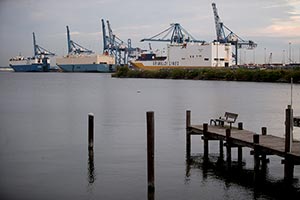Port of Baltimore Sets Cargo Record in 2016

The port of Baltimore handled a record 10.1 million tons of general cargo at its public terminals in 2016, a 5% increase from the previous year, officials announced Feb. 14.
In its first six months of welcoming larger containerships transiting the expanded Panama Canal, the port saw a nearly 10% increase in container volume at its terminals. That was due in part to a busy December, in which that traffic was up 23% from the same month last year, said James White, executive director of the Maryland Port Administration. The first of those larger vessels, the 1,095-foot Ever Lambent from Taiwan, called in Baltimore in July.
"Maryland's strategic investments in the Port of Baltimore have enabled the port to directly benefit from the expanded Panama Canal by serving the new megaships," Gov. Larry Hogan said in a statement.
The port handled the equivalent of more than 538,000 20-foot container units, or TEUs, last year, an increase of 3% from 2015.
Due to its location up the Chesapeake Bay and limited rail capacity, Baltimore's container traffic has long lagged its nearest competitor, Norfolk, Virginia, which outpaced it with more than four times as much container volume last year.
Maryland submitted a second application in December for federal funding to expand the Howard Street Tunnel under downtown Baltimore to make it tall enough for containers to be stacked two high on freight trains. Officials say renovating the outdated tunnel is key to ensuring the port's continued growth.
RELATED: Maryland seeks $155 million from feds to clear freight rail bottleneck beneath Baltimore
The state and Ports America Chesapeake entered into a $1.8 billion, 50-year lease deal in 2009 for Seagirt Marine Terminal, in which the company agreed to pay for a 50-foot-deep berth and four supersize cranes to load and unload the giant ships, in return for operating the facility.
That deal is paying off, White said. With the giant cranes and deep berth, Baltimore is one of four ports on the East Coast that can handle such massive vessels.
"The bigger ships are delivering the freight we thought they would," he said.
Baltimore also has been the nation's top port for autos for the past five years. The public terminals saw a dip of just over 1% in that category last year, to about 568,000 vehicles. The vehicle volume last year at the port's private terminals was not available Feb. 14.
RELATED: Auto imports continue to surge at Port of Baltimore
Roll-on/roll-off cargo, which includes farm and construction equipment, was down nearly 8%, to about 700,000 tons, officials said. Port spokesman Richard Scher attributed the drop to the dollar's strength hurting sales of American agriculture, construction and mining equipment.
"The silver lining is that while we lost tonnage, our market share remained No. 1 in the U.S.," he said.
Baltimore's port saw paper shipments increase 30% year-over-year to more than 519,000 tons. The port administration signed a 10-year contract extension with its top forest product customer, Finland-based UPM, in 2016. It also extended contracts with both of its cruise lines, Carnival Cruise Line and Royal Caribbean International.
White credited the longshoremen, Ports America and other contractors and companies at the port with the record cargo.
"The whole port community has been working together here to achieve these results," he said.

